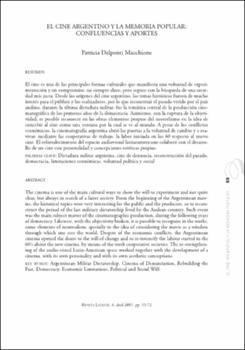El cine argentino y la memoria popular: confluencias y aportes
Author
Delponti Macchione, Patricia
Date
2005Abstract
El cine es una de las principales formas culturales que manifiesta una voluntad de experimentación
y un compromiso, no siempre claro, pero seguro con la búsqueda de una sociedad
más justa. Desde los orígenes del cine argentino, los temas históricos fueron de mucho
interés para el público y los realizadores, por lo que reconstruir el pasado vivido por el país
andino, durante la última dictadura militar, fue la temática central de la producción cinematográfica
de los primeros años de la democracia. Asimismo, con la ruptura de la objetividad,
es posible reconocer en las obras elementos propios del neorrelismo en la idea de
concebir al cine como una ventana por la cual se ve al mundo. A pesar de los conflictos
económicos, la cinematografía argentina abrió las puertas a la voluntad de cambio y a reavivar,
mediante las cooperativas de trabajo, la labor iniciada en los 60 respecto al nuevo
cine. El refortalecimiento del espacio audiovisual latinoamericano colaboró con el desarrollo
de un cine con personalidad y concepciones estéticas propias. The cinema is one of the main cultural ways to show the will to experiment and not quite
clear, but always in search of a fairer society. From the beginning of the Argentinean movies,
the historical topics were very interesting for the public and the producers, so to reconstruct
the period of the last military dictatorship lived by the Andean country. Such event
was the main subject matter of the cinematographic production, during the following years
of democracy. Likewise, with the objectivity broken, it is possible to recognize in the works,
some elements of neorrealism, specially in the idea of considering the movie as a window
through which one sees the world. Despite of the economic conflicts, the Argentinean
cinema opened the doors to the will of change and to re-intensify the labour started in the
60’s about the new cinema, by means of the work cooperative societies. The re-strengthening
of the audio-visual Latin-American space worked together with the development of a
cinema, with its own personality and with its own aesthetic conceptions.





